|
1.
FRANCOPHONE
WEST AFRICA
Market conditions remain unchanged
Prices remain firm but it is not clear yet how far West African exporters are going to follow Asian log price upward trend in 2006. Although log exports to Europe
continue to decline, the dull overall market situation in the major importing countries seems to have held back possible price hikes after few increases in January.
The Italian market is quiet, damp ening down production of ayous (wawa). Although the UK housing market is said to be resuming an upward trend and there are
somewhat controversial plans to build large numbers of new houses in the South East, the timber and joinery trade appear to be less optimistic about prospects for 2006.
Prices remain firm despite sporadic competition
Some West African exporters and traders feel that the recent resurgence of large log volumes in Northern Rep.of Congo and, intermittently, from Central African Republic has led to occasional fierce price competition in sapele and sipo logs and lumber. However, this might give the wrong impression of what is actually a very firm and rising market trend.
Concession in R. of Congo passes legality audit
The German Danzer Group has informed that one of its subsidiaries, Industrie Foresti¡¡¡¡━¬¡¡¡¡━¬re d'Ouesso (IFO), has passed an independent legality audit carried out by SGS in a forest concession in the Republic of Congo.
Passing the audit is seen as a major step to full certification. IFO is awaiting approval of its sustainable forest management plan from the Congolese authorities. SIFORCO, the other major Danzer Group subsidiary in the Democratic Republic of Congo, will undergo a similar SGS legality audit within the next few months. The Danzer Group is the world¡¯s largest manufacturer of sliced veneers.
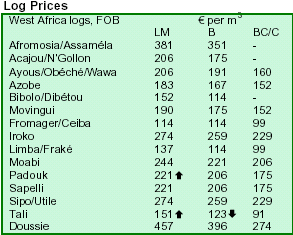
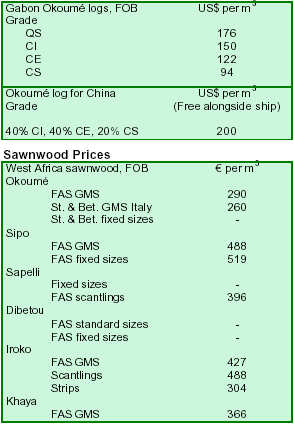
2. GHANA
Timber exports surged 8% in 2005
According to the Timber Industry Development Division (TIDD) of the Forestry Commission, export of wood products reached .184 million (466,155 m3) in 2005. This corresponds to 7.9% and 2.4% increments in value and volume, respectively, compared with 2004. The 7.9% increase in exports exceeds TIDD¡¯s projected 3.5% increase in revenue for 2005.
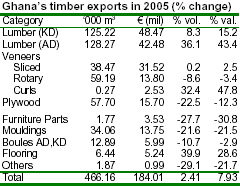
Exports up despite SPWP retreat
Of the total, secondary processed wood products (SPWP,furniture parts, mouldings, flooring, etc.) accounted for €29.5 million in 2005, down 14% from 2004, while primary products (lumber, veneer, plywood, etc.)
accounted for .154.5 million in 2005, up 13% from 2004. KD and AD lumber accounted for almost half of the total export volume in 2005. Compared with 2004,these products registered volume increases of 8% and 36%, and value increases of 15% and 43%, respectively.
According to TIDD, average unit prices for curls veneer, AD and KD lumber products rose 11.7% , 6.1% and 6.3%, respectively.
EU remains Ghana's main trading partner
The EU remains Ghana's major trading partner,accounting for €92.85 million (216,840 m3) in 2005. This trade is equivalent to 50% in value and 47% in volume of Ghana's total wood exports. Key markets include Italy, France, Germany, the UK, Belgium, Spain, Ireland and
the Netherlands.
The USA accounted for 15.6% and 15% of the total export value and volume in 2005 as compared with 14% and 16.4%, respectively, in 2004. This market remains the most lucrative destination for Ghana's plywood, lumber (KD) and rotary veneer exports. The ECOWAS countries (Senegal, Nigeria Gambia, Burkina Faso, Sierra Leone and Togo) accounted for 66% of Africa's euro19.6 million wood imports from Ghana in 2005. Plywood and AD lumber continue to draw interest in the Senegalese and Nigerian markets.
Asian and Far Eastern countries (India, Malaysia, Taiwan, China, Singapore, Thailand and the Philippines) accounted for €32.6 million (17.7%) of the total value of wood exports in 2005. India remains the leading importer of Ghana's teak AD lumber. Middle East countries
(Saudi Arabia, Lebanon, UAE and Israel) accounted for €8.5 million (4.6%) of the total export value in 2005.
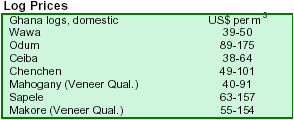
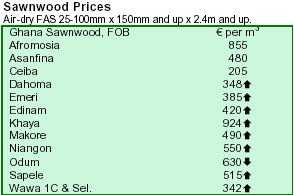

3.
MALAYSIA
Market begins to reactivate slowly
The Malaysian timber market begins to move slowly as the annual lunar new-year holidays come to an end. However, prices for most timber products surged again in early February due to reduced supply of wood raw material. Monsoon rains continued to affect logging and sawmilling operations in the major production areas.
Latex and palm oil push rubberwood prices up
Prices for rubber latex firmed at 7 Malaysian ringgit (MR) per kg. As a result, furniture and panel products manufacturers are facing an uphill task in securing raw material for production, as previously reported by the MIS. Over 80% of furniture manufactured in Malaysia is made of rubberwood.
The problem is compounded by rising prices of palm oil. With palm oil prices at 1,460 MR per ton, panel producers are having difficulties in securing palm fiber. Fibers from aged oil palm trees constitute the bulk of raw material for panel products, especially MDF. A number
of panel products manufacturers have turned to rubberwood as a source of raw material, thereby, aggravating an already tight supply situation.
Market analysts think that rubber latex and palm oil could hit 10 MR per kg at 1,500 MR per ton in the near future, respectively.
Malaysia proposes to host the AFIC secretariat
Malaysia has proposed the establishment of a permanent Asean Furniture Industries Council (AFIC) secretariat in Kuala Lumpur, during the AFIC Conference on 14 February.
AFIC chairman, Datuk Yong Seng Yeow said the proposed AFIC secretariat would be a base for Asean member countries to source data on raw timber materials and a development hub for furniture design.
The Deputy Minister of Plantation Industries and Commodities, Datuk Anifah Aman, indicated that the setting up of the secretariat in KL was also in line with the vision for Asean to be a major hub for high-end furniture industries. He stressed that Asean countries had
to work together towards being a manufacturer of high-end furniture to face rising competition from China.
Mr. Anifah added that Malaysia could play a pivotal role to promote competitiveness with its established position as the second biggest exporter in Asia and the leading exporter in Asean.
Costs hinder imports of temperate hardwood
Timber exporters from the US have limited success in penetrating the Malaysian market, with local manufacturers overtly concern about costs. Timber exporters from New Zealand, Nordic countries and Canada have yet to tap into the Malaysian market. The exception is IKEA, which operates several large home -furnishing depots in Malaysia, with great success.
In addition to costs, some Malaysian sawmillers argue that their machineries are not designed to work with temperate logs. Moreover, there is lack of technical expertise in working with such wood species.
New shipping service from Bintulu, Sarawak
Evergreen Marine Corporation, one of the world's largest mainline operators (MLOs), launched a new China-Indonesia-Manila (CIM) service from Sarawak's Bintulu International Container Terminal (BICT) in December 2005. The service deploys even bigger vessels in the range of 1,812 TEUs (twenty-foot-equivalent-units) capacity.
The weekly service calls direct at Manila and at few Chinese ports from Bintulu. Export growth is expected to improve this year, with optimism based on growing containerization of timber products, such as MDF, from the timber-rich Bintulu region.
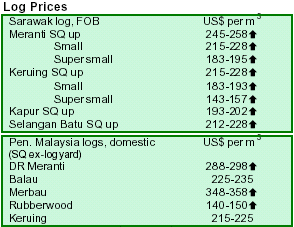
Peninsular Malaysian meranti logs are top grade and are used for
scantlings for the EU. Their prices are higher than Sarawak¡¯s.
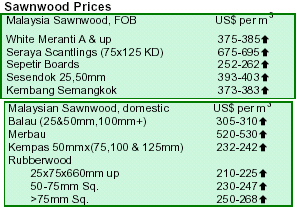
4.
INDONESIA
Panel producers unable to fulfil orders
Prices for most wood products went up amid lunar new-year celebrations while those for panel products showed mixed trends. Many Indonesian panel manufacturers have been unable to fulfil orders, affecting the confidence on supplies and bearing down prices. Buyers are increasingly wary of the market situation.
Plywood sector hit by closures and lay-offs
Nearly 50% of Indonesia's 126 plywood factories are lying idle due to difficulties in securing raw material, reported the newspaper "Bisnis Indonesia?"
The wood panel association (Apkindo) lamented that more than 10,000 workers may soon lose their jobs. About 60 of the 126 plywood companies in the country have been forced to cease operation while the rest operate below their production capacity. In 2005 about 350,000
workers lost their jobs in the country, up sharply from 138,000 in 2004. Almost half of the lay-offs were in the wood-processing industry, followed by the textile and garment sector.
Hadi Susanto, Director General, Forestry Research & Development Agency (FORDA) of the Ministry of
Forestry, indicated that many Indonesian plywood companies are neither efficient nor competitive as most of them are still using old machines. Painful adjustments may come down to more worker lay-offs.
Checks further troubled the wood industry
With the fight against illegal logging intensifying, some government officials, including many without authorization, have started to carry out unnecessary checks and raids on the supply of timber, according to Ms. Soewarni, Chair of the Indonesian Sawmill and Woodworking Association. This makes it even more difficult for mills to secure raw materials.
Ms. Soewarni contended that about half of the country's wood-based industries had collapsed due to high-cost and the prevalence of aging machinery amid increased competition from more efficient countries like China and Malaysia.
Wood exports continues to decline
Indonesia wood products exports have fallen from $3.28 billion in 2003 to $3.17 billion in 2004 and, further, to an estimated $2.8 billion in 2005. With no signs of an economic upturn yet, the outlook for the export industry seems uncertain. A planned hike in electricity rates (see MIS Report 11/2), if realized, would have an added negative impact on the industry.
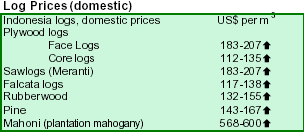
Sawnwood Prices
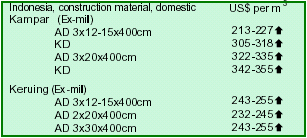
5.
MYANMAR
MTE raises direct sales teak prices
With its fiscal year coming to a close at the end of March, MTE, as usual, is expected to engage in more dynamic marketing to meet the targeted export earnings. MTE raised the prices for direct sales of teak logs from 1 February. Direct sales prices are at (US$ per hoppus ton FOB Yangon) $1,270-$1,677 for SG-4 grade, $999-$1,152 for SG-5 and $814-$890 for SG-5,
depending on the source region.
Market conditions unchanged for other logs
The gurjan market remains dull with fresh logs coming out of the forest while a significant backlog of earlier season¡¯s fellings lies in log depots. In contrast, the pyinkado market remains firm. The pyinkado market depends on the quality of available logs and the supply of
merbau from Indonesia.
Negotiations with China to end illegal trade
In a recent declaration to the press, the Minister of Forestry, Brigadier-General Thein Aung informed that Myanmar is currently undertaking negotiations with China to find ways to end the illegal extraction and trade of timber along their common border. The Minister made
the comments during a meeting at the International Business Center (IBC) in Yangon.
Annually, more than 100,000 tons of teak and other valuable hardwoods are illegally extracted from Kachin and Shan states in northern Myanmar and smuggled into
China, the Minister said.
According to London-based Global Witness, there are signs that Myanmar is treating the problem seriously, possibly because the illegal trade costs the country an
estimated $250 million a year in lost taxes.
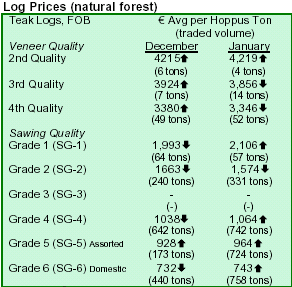
Hoppus ton=1.8m3; All grades, except SG-3, assorted and domestic, are length 8¡¯ x
girth 5¡¯ and up. SG-3 is girth 4¡¯ and up while assorted and domestic are girth 4¡¯ and up.
SG-3 grade is higher than SG- 4 but with lower girth and price.
6. PAPUA
NEW GUINEA
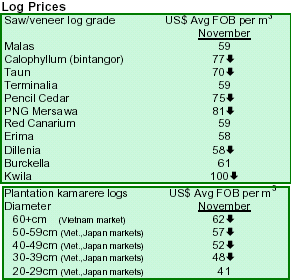
7.
BRAZIL
Forest plantations at 5.25 million ha in Brazil
Brazil's private forest plantations account for 5.25 million hectares or about 0.6% of the country's area. Although significant compared with other tropical countries, the
share of this area is lower than that under cattle raising (21%) and agriculture (6%). Forest plantations are predominantly eucalyptus (63%) and pine (37%). Pine is
mainly used for pulp and paper and solid-wood products, while eucalyptus is used for pulp and paper and charcoal production. Only 35% of the forest plantations are located in the temperate states of Paran? Santa Catarina, Rio Grande do Sul and southern Sao Paulo. The tropical state of Minas Gerais alone accounts for 32% of the plantations in Brazil. Most of the plantations were established in the 1970s due to fiscal incentives. Over 70% of the timber consumed in Brazil comes from forest plantations.
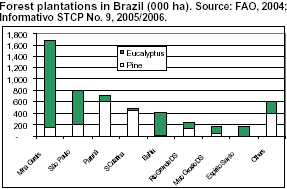
Mato Grosso inspects sawmill¡¯s operations
About 400 sawmills in the Northern region of the State of Mato Grosso will be inspected in a joint operation by the State Secretaries of Environment and Resources (SEMA and SEFAZ), and the Institute of Farming Defence (INDEA). The objective is to check changes in the new
SEMA one-registry system for businesses. Out of a total existing 4,000 sawmills registered under the previous system, more than 1,000 companies have ceased operations.
The inspections seek also to detect anomalies, such as the illegal sale of bills of sale transactions and ATPFs (authorization for forest products transportation), which affect those operating legally. Inactive companies will be excluded from the new registry system. The inspections will start with forest companies based in Sinop, the main regional forest production centre. Other companies in neighbouring cities will follow.
New law opens 13m ha for forest concessions
The Brazilian Senate has approved a Project of Law that provides for forest concessions of up to 3% of the Brazilian Amazon (nearly 13 million ha) for sustainable forest management (SFM). The forest concessions would last up to 40 years. The law would also create the
Brazilian Forest Service and the National Fund of Forest Development, with a focus on forest partnerships and labour training in the domestic solid wood sector.
The law aims at promoting SFM and combating illegal logging, deforestation and illegal land occupancy in the Amazon. Moreover, the law intends to transform biodiversity into actual assets and be the key for the long-term planning of the region. The Ministry of Environment (MMA) expected that within the next ten years, the area under concessions would generate direct annual revenues of 187 million Brazilian real (BRL), annual taxes of around 1.9 billion BRL and about 140,000 jobs.
Before the implementation of the law, the forests would be included in the National Public Forest Registry while an Annual Plan of Forest Concession would be elaborated to define the areas for concession. After the approval of the plan, each area would be studied and
divided into management units for the bidding process.
With the final approval of this project of law, the Brazilian Society of Silviculture (SBS) estimates that, in the next decade, investments in the Amazon region would double those made in the past 15 years. Some entrepreneurs are said to be ready to invest $8 billion in SFM projects in the region as soon as the law is approved.
Brazilian furniture exports hit $1 billion
Brazilian exports of furniture reached a record $1 billion in 2005, up 5.1% from 2004, according to ABIMOVEL
(Brazilian Association of Furniture Industries). The main market was the USA ($373.3 million) while Mercosur countries were ranked in sixth position. Argentina alone
imported $48.7 million, up 41% from 2004.
The furniture cluster in the Southern state of Santa Catarina led the exports with $443.9 million, followed by the cluster of Rio Grande do Sul ($ 272.3 million) and Sao Paulo ($104.4 million). These three southern furniture clusters accounted for over 80% of Brazil'sfurniture exports in 2005.
Furniture producers hope to remain competitive
The outlook of furniture exports for 2006 is pessimistic according to ABIMOVEL. Furniture exports might decline, especially if the US dollar remains between 2.20 and 2.30 BRL. Companies would prefer an average exchange rate in the area of 2.35 BRL. In addition, the
Presidential election in October this year adds uncertainty to the outlook.
Last year, the timber sector saw substantial lay-offs,reduction of private investments and closure of factories. This year, companies are hoping to be competitive by reducing the period of job contracts from 180 days to 60 days and undertaking partnerships with companies from other countries such as Mexico, Japan and countries in Mid-west Europe and South America. Moreover, some companies are focusing on the domestic market while increasing their participation in international fairs.
Furniture producers eye exports to Mercosur
A group of furniture companies from the Southern State of Rio Grande do Sul have initiated negotiations with importers from the three Mercosur countries (Argentina, Uruguay and Paraguay), for exports valued at $150,000 to take place over the next 12 months. This is one of the results of the Buyer Project promoted by the Brazilian Service of Support to Small Enterprises (SEBRA) through the SebraExport Furniture Program.
The Buyer project is also considering negotiations with other countries yet to be identified. The prospect of African markets and the participation of the Rio Grande
do Sul companies in the US High Point Trade Fair and the Dubai¡¯s Index Fair are also under consideration.

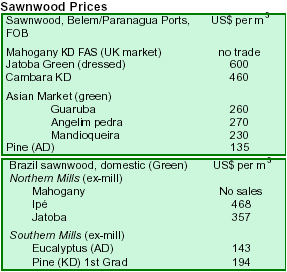
8. PERU
Peru losses $44.5 million to illegal logging
Peru¡¯s National Institute of Natural Resources (INRENA) estimated that economic losses from illegal logging in the country reached at least $44.5 million in 2005, compared with total timber exports of over $160 million that year. According to INRENA, illegal logging
represented 15% of the total national timber production. Mahogany (Swietenia macrophylla) and Spanish cedar (Cedrela odorata) are the species most targeted by illegal loggers. About 195 timber species are logged from the Peruvian forests, with mahogany and Spanish cedar
representing one-third of the total exports.
According to Marco Romero, chief of INRENA¡¯s CIEF
(Forest Strategic Information Center, established with ITTO funds in 1998), forest concessions and due controls of their operations are some of the tools to combat illegal
logging activities. Last year, 15 forestry concessions were terminated after timber harvesting outside of the concession areas was detected.
Uyacali calls measures against illegal logging
The National Forest Chamber and the Ucayali's Association of Forest Harvesters (AEMRU) sent a letter to INRENA on 1 February reporting illegal logging and trade activities and the involvement of several civil servants in Pucallpa (Ucayali). They called on INRENA
to take the following immediate measures:
¡¡¡¡━¡¡━ Proclamation of a state of emergency in the forestry activity in the Ucayali region.
¡¡¡¡━¡¡━ Investigation and sanction against to public officers involved in illegal logging issues.
¡¡¡¡━¡¡━ Reorganization of the INRENA office in Ucayali.
¡¡¡¡━¡¡━ Review of the POAs (Annual Operation Plans) and PGMF (General Forest Management Plans) not yet evaluated.
The associations seek to put in order the current forestry situation in the region, which is the country¡¯s largest
timber producer.
WWF supports capirona furniture for the USA
The World Wildlife Fund (WWF) and Peru's Furniture Consortium (CPM) concluded an agreement for a monthly supply of 15,000 m3 of capirona (Calycophyllum spruceanum) as part of WWF's support program to Peru's forest concessions.
The main purpose of the agreement is to reduce demand and commercial pressure on mahogany and Spanish cedar and promote lesser used species (LUS) in the international and domestic furniture markets. CPM plans to introduce capirona furniture in the US market. WWF
is also encouraging chain of custody and FSC certification in Peru.
COM is composed of five companies, four located in Lima (Muebles Laureano, Comarsa, Muebles Oregon and D¡¯Uno) and one in Trujillo (D¡¡¡′¬¦cor Mueble). In collaboration with the UNALM (National Agrarian University ¡¡ãLa Molina¡¡À), WWF is exploring other LUS,such as aguano masha (Paramachaerium ormosioides), for the furniture market.
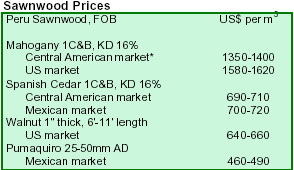
*Cheaper and small-dimension sawnwood for
this market.
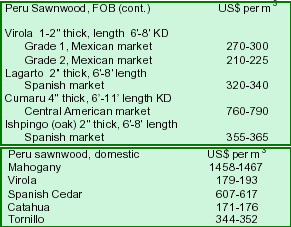
9. BOLIVIA
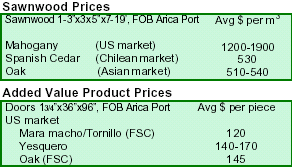
10. Guatemala
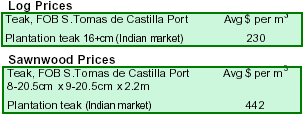
11.
Guyana
Guyana poised to be L.A.'s largest log exporter
The total value of Guyana's forest products exported reached almost $48.6 million in 2005, up 12% from 2004. The surge in exports was due to increases in exports of logs (up 67% in value), doors (66%), sawn lumber (28%) and living room and garden furniture (15%). The export value of plywood decreased 27% in 2005. Other products remained fairly stable.
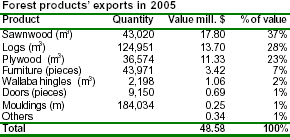
Sawnwood was the major export product in 2005,accounting for 37% of the total export value. The main markets for sawnwood were the Caribbean (notably Barbados), the USA and UK. Continued investment in the sawmilling sector is expected to result in increases in
the production and export of sawn lumber.
The number of exported log lesser used species (LUS) rose to 50 species. This is expected to continue in 2006 as more species gain recognition in the market place.
Guyana is set to overtake Ecuador as Latin America's largest exporter of tropical logs. The major destinations for Guyana's logs were India, China, Vietnam, Taiwan and Hong Kong.
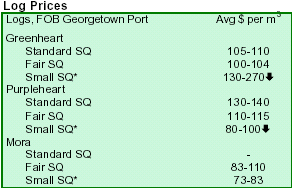
*Small SQ is used for piling in the USA and EU. Price depends on length.
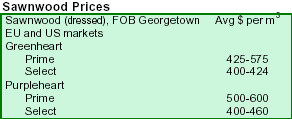
|